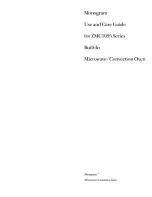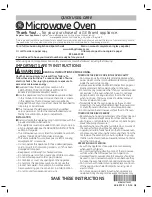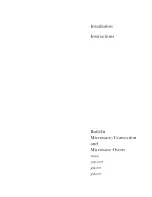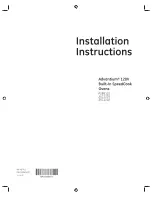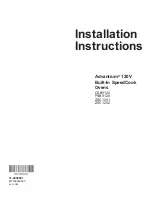
SMH7185
1/20/2012
4
WARNING:
It is critical to route wires and
wire harness identical to the way they were,
to prevent electromagnetic interference caus-
ing possible fault codes.
Procedure for measurement of microwave energy leakage
1. Pour 275±15cc of 20±5°C(68±9°F) water in a beaker which is
graduated to 600cc, and place the beaker in the center of the oven
2. Start to operate the oven and measure the leakage by using a mi-
crowave energy survey meter.
3. Set survey meter with dual ranges to 2,450MHz.
4. When measuring the leakage, always use the 2 inch spacer cone
with the probe. Hold the probe perpendicular to the cabinet door.
Place the spacer cone of the probe on the door and/or cabinet door
seam and move along the seam. The door viewing window and the
exhaust openings moving the probe in a clockwise direction at a
rate of 1 inch/sec. If the leakage testing of the cabinet door seam is
taken near a corner of the door, keep the probe perpendicular to
the areas making sure that the probe end at the base of the cone
does not get closer than 5 cm to any metal. If if gets closer than 5
cm, erroneous readings may result.
5. Measured leakage must be less than 4mW/cm2 after repair and
adjustment.
Maximum allowable leakage is 5mW/cm2. 4mW/cm2 is used to allow
for measurement and meter accuracy.
Microwave Cooking Wattage Test
Safety precautions
High Voltage Warning
Do not attempt to
measure any of the high voltages --this in-
cludes the filament voltage of the magnetron.
High voltage is present during any cook cycle.
Before touching any components or wiring,
always unplug the oven and discharge the
high voltage capacitor
Some semiconductor (“solid state”) devices
are easily damaged by static electricity. Such
components are called
Electrostatically
Sensitive Devices (ESDs).
Examples
include integrated circuits and field-effect
transistors. Immediately before handling any
semiconductor components or assemblies,
drain the electrostatic charge from your body
by touching a known earth ground.
Temp Rise
Output
Temp Rise
Out-
put
5
194
23
891
6
232
24
930
7
271
25
969
8
310
26
1007
9
349
27
1046
10
387
28
1085
11
426
29
1124
12
464
30
1162
13
504
31
1201
14
542
32
1240
15
581
33
1279
16
620
34
1317
17
659
35
1356
18
697
36
1395
19
736
37
1434
20
775
38
1472
21
814
39
1511
22
852
40
1550
Fill a 1000ml plastic room temperature container with cool tap water,
temperature of the water should be 55-65 degrees
Stir water with a thermometer and record the water temperature, remove
thermometer.
Place the container in the center of the lowest shelf or center of the
bottom of the microwave.
For units less than 1550 watts, operate the oven on high for exactly 63
seconds.
Using the thermometer, stir the water to check the temperature of the
water.
Subtract the starting temperature from the final temperature; this will be
the temperature rise.
NOTE: Check line voltage under load, lower line voltage will lower
the power output.
M/W Power
1100
Watts
M/W Weight
54.23 lbs
Primary low
0.43Ω
Primary high
0.39Ω
Secondary
125
Filament
0.0Ω
TT Stirrer
Motors
120Ω
Fan Motor
45Ω
Vent, at run
cap (checks
all windings)
100Ω
Motors
M/W Information
Specifications
High Voltage
Transformer
Содержание SMH7185
Страница 2: ...SMH7185 1 20 2012 2...





